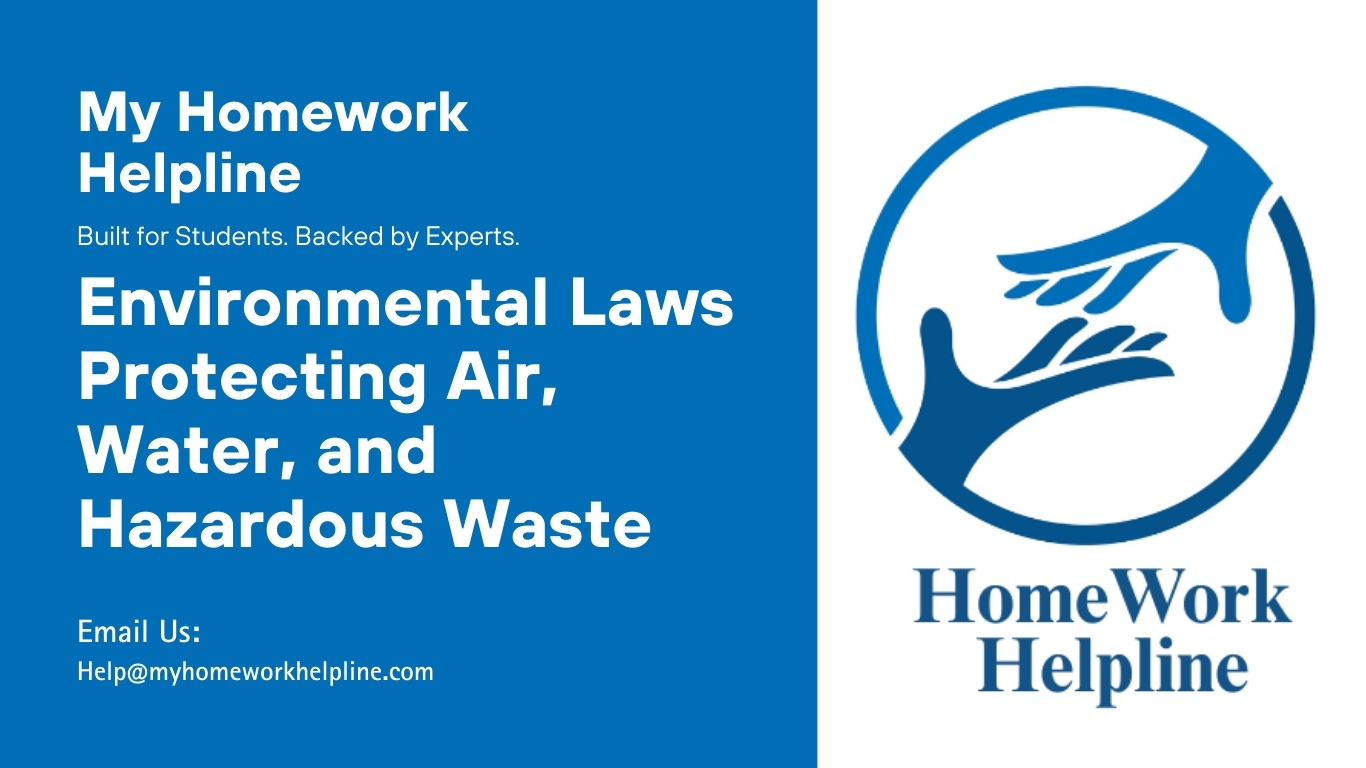Environmental Laws and Regulations Essay: Air, Water & Hazardous Waste
The Clean Air Act of 1963 is considered the first major Federal Legislation tailored toward improving air quality. The core function of the act is to ensure there is reduction of air pollution, as instructed by the congress. Equally, the clean air act created several amendments upon its original passage, and identical amendments were conducted in 1990. It mandates the Environmental Protection Agency to enact a national rule concerning air quality. In addition, the clean air act aims to develop state implementation plans that will detail how these states will adhere to the national ambient air quality and other required expectations.
Moreover, the federal water pollution act established in 1972, also considered a clean water act, was enacted to ensure there is restoration maintaining of waters based on its chemical, biological, and physical nature for all nations. The act also requires the Environmental Protection Agency to ensure there is implementation of the national pollutant discharge. The exclusion system permits that will work towards eliminating the discharge of pollutants to water bodies (Elmagrhi et al., 2019). Furthermore, the act requires national stages to implement maximum loads on a daily basis that will also enact limits on the number of pollutants discharged to a given water surface.
If you need expert assignment and homework assistance for environmental law or regulatory compliance topics, we can help. Our team offers professional support with essays, research papers, and academic assignments on the Clean Air Act, Clean Water Act, RCRA, and other environmental laws. Visit our Law Homework Helpline today for reliable homework help and ensure your assignments meet top academic standards while saving time.
In addition, the Resource Conservation and Recovery Act implemented in 1976 was purposely initiated to regulate the generation, transport, storage, disposal and treatment of the hazardous waste. According to Elmagrhi et al. (2019), the implementation of this act was associated with various demands. The act requires the Environmental Protection Agency to outline multiple measures that will be adhered to reduce the risks encountered by using chemicals. Mandatory disclosure is associated with information that illustrate the chemical types, their location, where they should be stored, and how to use them safely. Appropriate handling procedures and suitable emergency response plans must also be disclosed (Jha et al., 2022). Therefore, the Risk Conservation and Recovery Act require that hazardous waste generators implement waste management plans designed to minimize the risks posed by these chemicals to the environment.
Consequently, a risk management plan is also part of the clean air act. A risk management plan is required when chemicals in gaseous forms, such as ammonia and chlorine, are used in large quantities. The plan outlines various measures that will be taken to reduce the risks associated with the use of chemicals. Such details include core sections of an employee’s information describing their handling training, the company’s chemical inventories, and emergency procedures (Elmagrhi et al., 2019). Furthermore, pretreatment categorical standards are considered regulations of the Environmental Protection Agency issued to implement limits for specific industrial categories. The core purpose of these standards is to effectively minimize the number of pollutants discharged into public waters (Jha et al., 2022). Enacting these standards limits the number of pollutants that can be released into the environment and thus require the discharger to install pretreatment devices like grease traps and oil separators.
Generators of hazardous waste are grouped into exempt small quantity generators and small quantity generators, or large quantity generators. Exempt small-quantity generators emit less than 100 kilograms of hazardous waste in a month. These generators are not obligatory to obtain a waste permit but must comply with the speculated regulations (Jha et al., 2022). Small-quantity generators also emit more than 100 kilograms but less than 1000 kilograms of waste per month and must obtain a permit. In addition, the large quantity generators produce more than 1000 kilograms of waste in a month. They must also adhere to the license and keep detailed records of their waste management activities.
An example of the clean air act is the regulation of emissions from cars and other vehicles. This regulation is essential since I depend on my car to get around. Thus, the act requires car manufacturers to manufacture vehicles with lower emissions levels to reduce pollution and improve air quality. Equally, an example of federal water pollution control is the regulation of agricultural land runoff. The regulation is essential to me because I live near areas impacted by the impact of runoff on the local water supply. Thus, the act will minimize the runoff that enters the local waters. Regulation of hazardous waste disposal is an example of the resource conservation and recovery act. It is significant to me since my health, and that of many other residents, is at risk from hazardous waste disposed near us; hence, the act will require the company to dispose of the waste according to strict regulations.
References
Elmagrhi, M. H., Ntim, C. G., Elamer, A. A., & Zhang, Q. (2019). A study of environmental policies and regulations, governance structures, and environmental performance: The role of female directors. Business strategy and the environment, 28(1), 206-220. https://doi.org/10.1002/bse.2250
Jha, R., Dwivedi, S., & Modhera, B. (2022). Measurement and practices for hazardous waste management. In Hazardous Waste Management (pp. 89-115). Elsevier. https://doi.org/10.1016/B978-0-12-824344-2.00011-2

